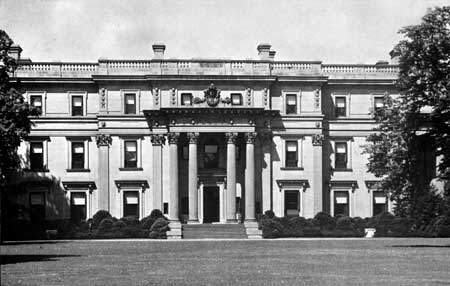|
VANDERBILT MANSION National Historic Site |
 |

Vanderbilt Mansion
VANDERBILT MANSION National Historic Site, at Hyde Park, N. Y., is a monument to an era. It is a magnificent example of the palatial estates developed by financiers and industrialists in the period between the Civil War and World War I—a time when the United States surged into world prominence as an industrial nation and the new age of machines created great wealth that was almost untouched by taxation.
Focal point of the site is the mansion. Built in the Italian Renaissance style, its architecture and its furnishings show how strongly European art and culture influenced wealthy Americans at the turn of the 20th century. Vanderbilt Mansion is figuratively a palace transplanted from the Old World to the banks of the historic Hudson River.
The extensive grounds surrounding the mansion have been a part of great estates for almost two centuries. From natural terraces fronting the Hudson, the grounds level off to the open woods and lawns of an English-type park, then descend to forested seclusion in the valley of Crum Elbow Creek. Notable specimen trees dot the landscape, many of them from Europe and Asia. All these features combine to provide a setting worthy of the mansion itself.
Frederick William Vanderbilt made this estate his country home for 43 years, from 1895 until his death in 1938. Frederick was a grandson of Cornelius Vanderbilt—the Commodore—who had founded the family fortune in shipping and railroading.

The Vanderbilt Name and Fortune
The name Vanderbilt (originally van der Bilt) was prominent throughout most of the 19th and early 20th centuries. This was largely due to the wealth of the family and the importance of its members in the transportation industry.
Cornelius Vanderbilt was a descendant of Dutch settlers who had migrated to America in the latter half of the 17th century. He first became interested in shipping while helping his father in odd jobs of boating and lightering around New York Harbor. When still a young man, he went into business for himself. He prospered, and soon his ships were calling at ports around the world.
Railroads were expanding rapidly at the time; but not until late in his life—at the urging of his eldest son, William Henry—did Cornelius Vanderbilt become interested in this new phase of transportation. Soon the name Vanderbilt was inseparable from railroading in the United States.
After the Commodore's death in 1877, William expanded the Vanderbilt railroad interests in a number of systems, including the New York Central. When he died quite suddenly in 1885, several of his sons, left with substantial holdings of stock, increased their participation in the active management of the roads. One of these sons was Frederick William, future builder of Vanderbilt Mansion.

Frederick W. Vanderbilt as a young man.
Born February 2, 1856, Frederick had attended Yale before entering his father's office. In 1878 he had married Louise Holmes Anthony, daughter of Charles L. Anthony, prominent financier of New York City and Newport, R.I.
Aside from his business, Vanderbilt had few active interests, but was devoted to yachting. He was associated with Mrs. Vanderbilt in many philanthropic endeavors, particularly those related to young people; and he gave generously to several institutions of higher learning. Benefited during his lifetime and provided for in his will were Yale; Vanderbilt University at Nashville, Tenn.; and the Vanderbilt Clinic at Columbia University, built in memory of his father. Vanderbilt avoided personal exploitation of his benefactions just as he avoided membership in clubs and organizations of the type that might bring his name to public attention through officership or committee activity. This preference for anonymity continued until his death at Hyde Park on June 29, 1938, at the age of 82.
Vanderbilt was buried in the family mausoleum at New Dorp, Staten Island. He left no immediate survivors, for his wife had died in Paris 12 years earlier and they had had no children.
An accounting of the estate revealed that Vanderbilt, although retired for some years, had retained directorships in 22 railroads and many other corporations. His chief holdings were in the New York Central railroad system, a Vanderbilt enterprise from its beginning. The fortune he left amounted to more than $78 million.

|

|

| History | Links to the Past | National Park Service | Search | Contact |
|
Last Modified: Mon, Mar 4 2002 10:00:00 pm PDT |

